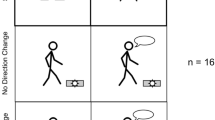Abstract
Carrying out the daily activities of work and play requires the ability to integrate available sensory information in order to navigate complex, potentially cluttered, environments. The expression of locomotor adjustment behaviour is still maturing during mid- to late-childhood (Grasso et al. in Neurosci Biobehav Rev 22(4): 533–539, 1998a; McFadyen et al. in Gait Posture 13:7–16, 2001), which raises the question, do children coordinate their body segments differently than adults when circumventing an obstacle in their travel path? Healthy young children (n=5; age 10.3±1.5 years) and adults (n=6; age 26.3±2.9 years) were asked to walk at their natural pace during unobstructed walking, as well as during the avoidance to the right or left of a cylindrical obstacle located in the travel path 3 m from the initial starting position. Fourteen infrared markers were fixed to participants and tracked using the Optotrak motion analysis system (60 Hz; Northern Digital Inc, Canada). Data analyses included center of mass (COM) clearance from the obstacle, gait speed, angular movement of the head and trunk (yaw, pitch and roll) and medial–lateral (M-L) COM displacement. Onset of change in these variables from unobstructed walking was also calculated as the time from OBS crossing. Although there were no differences in when adults or children altered their M-L COM trajectory, adults reoriented their head and trunk segments at the same time as their COM while children reoriented their head and trunk prior to changing COM direction. A comparison of foot placement data for this task indicated that while adults changed their gait patterns well in advance of obstacle crossing, children initiated M-L adjustments to gait patterns just prior to OBS crossing. Vallis and McFadyen (Exp Brain Res 152 (3):409–414, 2003) indicated that during circumvention of an obstacle, adults coordinate body segments for a single transient change in COM trajectory while maintaining the underlying travel direction. The present data suggest, however, that children partition obstacle avoidance into two tasks, initially steering with proactive movement of the head and trunk segments and finally making adjustments to their gait trajectory, via stride and step width changes, to ensure adequate obstacle clearance just prior to obstacle crossing. This study demonstrates different anticipatory control strategies used by children as compared to adults to circumvent obstacles in the travel path. The different head and trunk anticipatory segmental coordination suggests that children gather visual information differently when circumventing an obstacle in their travel path and are more dependent on visual input to guide their circumvention strategy.


Similar content being viewed by others
References
Assaiante C (1998) Development of locomotor balance control in healthy children. Neurosci Biobehav Rev 22(4):527–532
Assaiante C, McKinley PA, Amblard B (1997) Head-trunk coordination during hops using one or two feet in children and adults. J Vestib Res 7(2–3):143–160
Assaiante C, Amblard B (1993) Ontogenesis of head stabilization in space during locomotion in children: influence of visual cues. Exp Brain Res 93:499–515
Assaiante C and Amblard B (1995) An otogenetic model for the sensorimotor organization of balance control in humans. Hum Mov Sci 14:13–43
Assaiante C, Woollacott M, Amblard B (2000) Development of postural adjustment during gait initiation: kinematic and EMG analysis. J Mot Behav 32(3):211–226
Berthoz A, Viaud-Delmon I (1999) Multisensory integration in spatial orientation. Curr Opin Neurobiol 9:708–712
Grasso, R Glasauer S, Takei Y, Berthoz A (1996) The predictive brain: Anticipatory control of head direction of the steering of locomotion. Neuroreport 7:1170–1174
Grasso R, Assaiante C, Prevost R, Berthoz A (1998a) Development of anticipatory orienting strategies during locomotor tasks in children. Neurosci Biobehav Rev 22(4):533–539
Grasso R, Pévost R, Ivankeo YP, Berthoz A (1998b) Eye-head coordination for the steering of locomotion in humans: an anticipatory synergy. Neurosci Lett 253:115–118
Jensen RK (1986) Body segment mass, radius and radius of gyration proportions of children. J Biomech 19:359–368
Malouin F, Richards CL (2000) Preparatory adjustments during gait initiation in 4–6 year old children. Gait Posture. 11:239–253
McFadyen BJ, Malouin F, Dumas F (2001) Anticipatory locomotion control of obstacle avoidance in mid-childhood ages children. Gait Posture 13:7–16
McFadyen BJ and Winter DA (1991) Anticipatory locomotor adjustments during obstructed human walking. Neurosci Res Commun 9:37–44
Ounpuu S, Gage JR, Davis RB (1991) Three dimensional lower extremity joint kinetics in normal pediatric gait. J Pediatr Orthop 11:341–349
Patla AE, Adkin A, Ballard T (1999) On-line steering: Coordination and control of body centre of mass, head and body reorientation. Exp Brain Res 129:629–634
Patla AE, Prentice SD, Robinson C, Neufeld J (1991) Visual control of locomotion: Strategies for changing direction and going over obstacles. J Exp Psychol Hum Percept Perform 17(3):604–634
Patla AE and Prentice SD (1995) The role of active forces and intersegmental dynamics in the control of limb trajectory over obstacles during locomotion in humans. Exp Brain Res 106:499–504
Rose DJ (1997) “The nature of motor learning” in, A multi-level approach to the study of motor control and learning. Allyn & Bacon Publishers, Needham Heights
Vallis LA, McFadyen BJ (2003) Locomotor adjustments for circumvention of an obstacle in the travel path. Exp Brain Res 152 (3):409–414
Winter DA (1990) Biomechanics and motor control of human movement, 2nd edn. Wiley, Toronto
Acknowledgements
We would like to thank the children and parents who participated in the study. We acknowledge and would like to thank the following people for their technical assistance: Mr. Guy St-Vincent, Mr. Martin Gérin-Lajoie, Mr. Francois Comeau and Mr. Claude Simard. Financial support from NSERC (BJM) and a post-doctoral fellowship to LAV (CIRRIS).
Author information
Authors and Affiliations
Corresponding author
Rights and permissions
About this article
Cite this article
Vallis, L.A., McFadyen, B.J. Children use different anticipatory control strategies than adults to circumvent an obstacle in the travel path. Exp Brain Res 167, 119–127 (2005). https://doi.org/10.1007/s00221-005-0054-6
Received:
Accepted:
Published:
Issue Date:
DOI: https://doi.org/10.1007/s00221-005-0054-6




